5 Signs Your Inventory System is Holding Back Your Growth in Multi-Channel Sales
Running a business with inventory inefficiency is like trying to drive a car with a flat tire. Sure, you might still reach your destination, but it’ll be a frustrating, bumpy journey that wastes time, energy, and resources. In today’s competitive world of retail, having a seamless and effective inventory system is no longer optional—it’s a critical factor for growth, especially when operating across multiple sales channels.
Successful retailing demands more than just flashy storefronts and engaging promotions; it hinges on proficient inventory management. Did you know that inventory-holding expenses alone often account for at least 20% of a company’s total inventory value? These hidden costs can eat away at profits and hamper your ability to invest in growth opportunities. For businesses relying on outdated or fragmented systems, these inefficiencies often snowball, creating bottlenecks that slow fulfillment and erode customer satisfaction.

The stakes are even higher in e-commerce, where 70% of shoppers use multiple channels before making a purchase. Cross-channel shoppers aren’t just a growing trend—they’re 30% more valuable over their lifetime than single-channel buyers. To capture and retain these high-value customers, businesses must adopt a multichannel strategy supported by an inventory system that ensures seamless operations across every touchpoint. Without it, opportunities for growth can quickly turn into challenges that hold you back.
Recognizing the Red Flags: Top Indicators of Inventory Inefficiency
Managing inventory effectively is a cornerstone of business success, yet many companies fail to notice the subtle warning signs that their system is faltering. Inventory inefficiency doesn’t just impact your stockroom; it can ripple through your entire operation, affecting sales, customer satisfaction, and profitability. Recognizing these red flags early is crucial to implementing solutions before they escalate into major problems.
Here are 5 of the most common indicators of inventory inefficiency that every business should watch for:
- Stockouts and Overstocking: A clear sign of poor inventory management is the inability to maintain the right stock levels. Regularly running out of popular items leads to lost sales, while overstocking ties up capital and incurs storage costs.
- High Rate of Dead Stock: If your shelves are filled with items that haven’t sold in months, it’s a sign that your inventory system isn’t keeping pace with demand trends.
- Frequent Order Errors: Mistakes like shipping the wrong product or delivering incorrect quantities often point to fragmented systems or lack of coordination.
- Excessive Manual Processes: If your team relies heavily on spreadsheets or other manual tracking methods, it often leads to inefficiencies, data inaccuracies, and wasted time that could be better spent on strategic tasks.
- Inconsistent Inventory Reports: When inventory reports from different platforms or locations don’t align, it’s a clear indication of poor system integration. This can lead to inaccurate forecasting and difficulty in making informed business decisions.

Beyond these specific signs, inefficiency often manifests through operational bottlenecks that slow down processes and frustrate employees. For instance, if your team spends hours reconciling inventory data across multiple platforms, your system may be outdated or overly complex. Similarly, fulfillment delays caused by disorganized warehouses can lead to negative customer reviews and lost loyalty. These inefficiencies hurt not only the bottom line but also your brand reputation.
Addressing these issues begins with identifying their root causes. For many businesses, the problem lies in relying on outdated manual processes or systems that don’t scale with growth. Investing in modern inventory management tools, automating repetitive tasks, and integrating data across all sales channels are essential steps to building an efficient operation. By proactively recognizing and addressing these red flags, businesses can unlock greater profitability, smoother operations, and higher customer satisfaction.
The Hidden Costs of Poor Inventory Management
Poor inventory management doesn’t just lead to inefficiencies—it actively drains resources and limits business potential. While the most visible issues may appear as stockouts or overstocks, the hidden costs can be far more damaging, impacting finances, operations, and customer relationships. Businesses operating in multi-channel sales environments are particularly vulnerable, as the complexity of managing multiple platforms magnifies these costs.
One of the most significant hidden costs is missed sales opportunities. When popular products are out of stock, customers quickly turn to competitors, leading to immediate revenue loss and long-term damage to customer loyalty. Conversely, overstocking results in capital being tied up in unsold goods, increasing storage costs and reducing liquidity. This imbalance also leads to outdated inventory that may need to be sold at steep discounts or written off entirely, further eroding profit margins.
Operational inefficiencies also represent a significant cost. For example, teams burdened by manual processes spend countless hours reconciling inventory data, correcting errors, and managing discrepancies across multiple channels. These inefficiencies not only increase labor costs but also slow down fulfillment, causing shipping delays and frustrated customers. Additionally, fragmented systems make it difficult to generate accurate demand forecasts, leading to poor decision-making and reduced competitiveness in the market.
Finally, the ripple effects of poor inventory management extend to your brand reputation and customer satisfaction. Fulfillment errors, delays, or an inability to meet demand can result in negative reviews and lost trust. In the age of multi-channel sales, where 70% of shoppers interact with multiple platforms before purchasing, failing to deliver a seamless experience can significantly reduce customer lifetime value.
To avoid these hidden costs, businesses must invest in robust inventory management systems that provide real-time visibility, automation, and integration across all sales channels. These tools not only streamline operations but also empower decision-makers with actionable insights to drive growth. By addressing these hidden costs head-on, businesses can protect their bottom line and foster a foundation for sustainable success.


